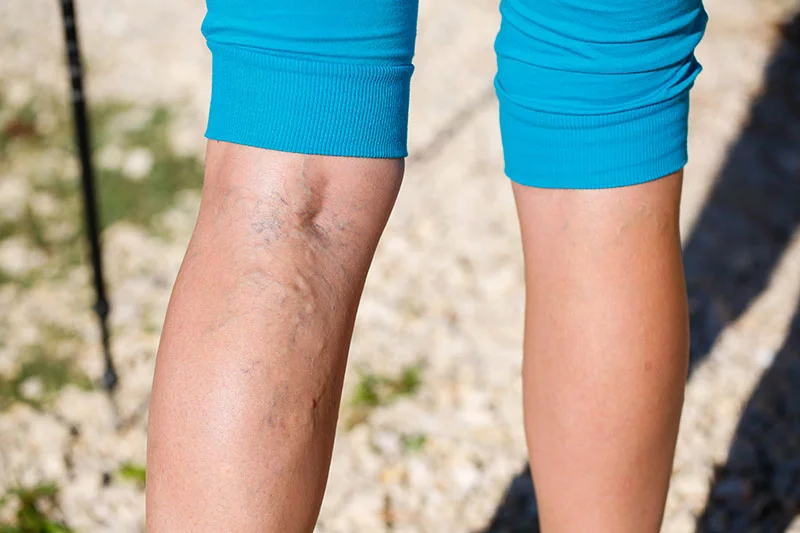
When President Donald Trump’s recent annual physical yielded a diagnosis of chronic venous insufficiency, medical experts were quick to note that its consequences are not typically as fearsome as the name might indicate.
In fact, chronic venous insufficiency — known to most by its most typical symptom, varicose veins — is quite common. About one in four U.S. adults has chronic venous insufficiency. If you count spider veins, it’s more like eight in 10 of us. Typically, they don’t cause problems. But sometimes, they do.
For a rundown of the causes, risks, and treatments for chronic venous insufficiency, we touched base with Dr. Max Wohlauer, a University of Colorado School of Medicine associate professor of vascular surgery who treats patients at the UCHealth Cardiac and Vascular Center on the Anschutz Medical Campus.
What causes chronic venous insufficiency or varicose veins?
Also called lower extremity chronic venous disease, chronic venous insufficiency happens when the superficial veins (that is, those close to the skin) in the lower legs have trouble moving blood back toward the heart.
That “superficial” is important, Wohlauer says, because the varicose and spider veins we see — not to mention the superficial great and small saphenous veins we don’t, which feed what become visible varicose veins — don’t carry much of the legs’ circulatory load. Deeper veins take care of that, and the muscles surrounding those veins are much more helpful in pushing blood back toward the heart, so venous insufficiency is rare in those deep leg veins.
The trouble with chronic venous insufficiency usually boils down to tiny backflow valves in the veins failing to close fully. That, plus gravity, can eventually lead veins, which are thin-walled and lack the muscle sheaths of arteries, to distend.
“We call it reflux, which causes blood to pool in your lower leg veins,” Wohlauer says, “Because of that, very small veins that would normally be barely visible to the eye can get engorged and turn into prominent, ropelike varicose veins.”
Who tends to get chronic venous insufficiency?
Varicose and spider veins tend to appear when people are in their 30s and 40s, Wohlauer says. It’s more common in women and among those who are on their feet a lot — including store clerks, nurses and doctors, restaurant workers and manual laborers. Genetics plays a big role: If both parents have varicose veins, their children have a roughly 90% chance of having them too, Wohlauer says.
How is chronic venous insufficiency diagnosed?
If varicose veins aren’t causing problems such as itching or pain, there’s usually no need to intervene, Wohlauer says. But particularly if there’s swelling in the lower legs, people should head to a doctor, because that can be a warning sign for heart, liver, lymphatic, and other potentially serious health issues.
If varicose veins are causing itching, burning, or pain, it’s time to get checked out. If sores on the lower legs appear, definitely see a doctor, Wohlauer says.
Diagnosis involves a few steps. The first is a physical exam and an ultrasound to determine where on the CEAP classification system the venous disorder lands. The ultrasound focuses not on the varicose or spider veins, but rather the otherwise hidden saphenous veins from which they branch off. The ultrasound provides an objective measurement of what’s happening in two ways: by looking at the veins’ diameter, and through an understanding of how quickly the veins’ valves close – ideally within a half second, Wohlauer says.
During a follow-up visit, Wohlauer discusses risks and treatment options with the patient.
Are varicose veins dangerous?
As vascular problems go, chronic venous insufficiency is usually low risk. It rarely leads to serious issues such as deep-vein thromboses (DVTs, or blood clots in the deeper, workhorse leg veins) or pulmonary embolisms (blood clots that end up in the lungs), Wohlauer says. But clots that do sometimes form in varicose veins can cause superficial thrombophlebitis, which can burn, itch, and cause swelling.
If varicose veins aren’t causing symptoms, ongoing monitoring may be the best option, Wohlauer says, with the caveat that “symptoms are in the eye of the beholder.” And if you’re having symptoms, it’s important to know that there are effective treatments, he adds.
What are some treatments for chronic venous insufficiency?
Compression stockings are typically the first-line treatment for cases that don’t involve ulcers, Wohlauer says. Patients typically put them on in the morning and take them off before bed. Often, it takes a couple of weeks for symptoms to abate, he says.
There are also minimally invasive surgical interventions: thermal ablation and chemical ablation.
Both involve numbing the skin and penetrating the varicose vein with a needle. Thermal ablation uses either a laser or a radiofrequency probe to heat the inner lining of the vein, which closes it off. Chemical ablation injects a chemical that irritates the vein’s lining and similarly shuts it down. The varicose veins go away, and the deep leg veins maintain normal blood flow.
“We have a whole array of tools to treat various conditions depending on what the symptoms are,” Wohlauer says. “We can do a lot of good to help people feel better.”
